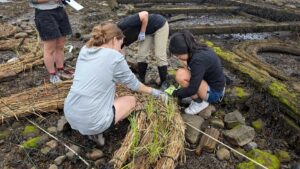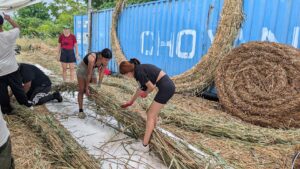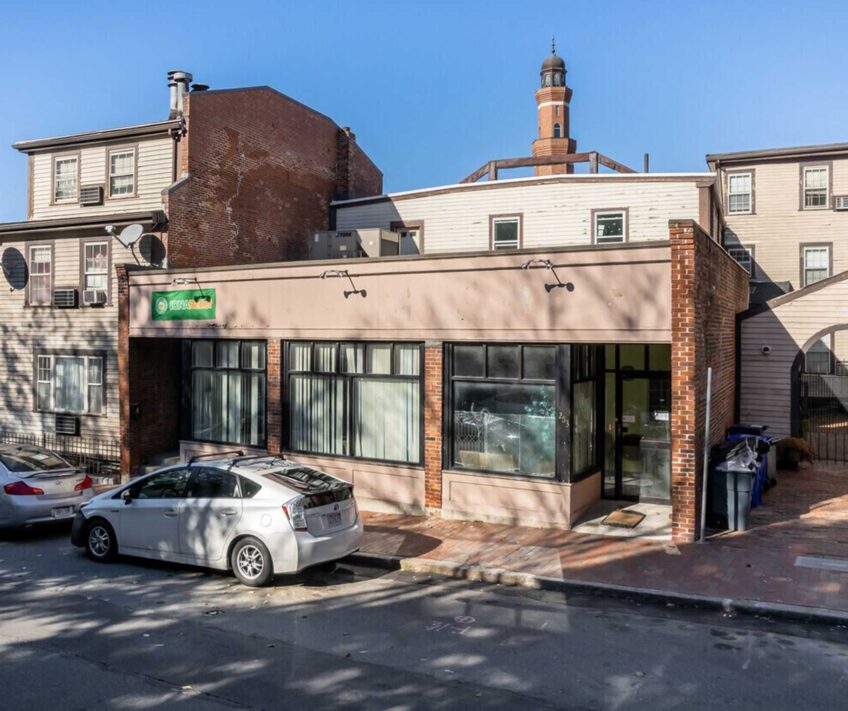E. Boston resilience effort puts shoreline future in the hands of local youth

At an old, unused industrial site along the East Boston harbor, a new local effort is engaging local students to explore ways to make the shoreline more resilient.
What was once an unused beach area and former site of a shipbuilding yard now is the home of curving, swirling bundles of cut reeds, each structure planted with grasses local to New England salt marshes and anchored along the beach to create a barrier against increased waves from storms.
The work is part of Eastie Farm’s Climate Corps program, a paid fellowship program for local community youth to learn about climate change and have hands-on experience working to assist efforts around resilience and food security.

Local East Boston youth build structures out of reeds to plant marsh grasses as part of the Climate Corps Fellowship program run by Eastie Farm. In collaboration with two research groups, the fellows worked to plant grasses native to salt marshes as part of an experiment to increase coastal resilience. PHOTO: COURTESY EASTIE FARM
Now in its fourth year, the program has changed and evolved year to year. This time around, it’s funded through a $1 million National Science Foundation grant, but in the past it has been supported by the city’s Department of Youth Employment.
Through the program, kids from the community have worked with local research teams to harvest reeds and bundle them together and plant them with marsh grasses before installing them along a parcel of shoreline where the harbor starts to narrow into Chelsea Creek and the Mystic River.
The issue of coastal resilience is one that is striking East Boston with increasing urgency, but while the city is launching efforts to protect shorelines, municipal efforts often rely on longer timelines as the city seeks out financial support from state or federal sources.
For example, at Tenean Beach in Dorchester, the city is looking to pull funds from a Federal Emergency Management Agency source for coastal resilience work that would include restoring salt marshes there, as well as raising land on the beach to protect from storm action. Approval process for that funding, however, could take anywhere from one to five years.
Gideon Neave, one of the Climate Corps youth fellows, said he has heard a lot of discussion but little work around addressing resilience.
“All Boston, but especially East Boston, is really at risk, and already, sea level rise has an impact. … I feel like you hear a lot of talk about it and fixing it, but I haven’t seen a lot actually happen,” said Neave, a lifelong East Boston resident.
Being able to be part of an effort actually working to change things “meant a lot,” he said.
“Seeing this empty beach that has been neglected for a long time … and being able to see them change and use them and spend time on them [was meaningful],” Neave said.
For the climate fellows, the work brings the topic closer to home in a way that a classroom might not, said Jenny Wechter, director of operations and education at Eastie Farm.
“For youth living in East Boston, growing up in this neighborhood, they feel the impact of these things already,” Wechter said. “Then they go to school, and if climate change is talked about at all, they’re talking about polar bears and the Arctic and the atmosphere, but they’re not talking necessarily about things that are happening specifically in their own community.”
Neave, who just started his senior year at Boston Latin School, said that he has had little classroom education about climate change at all, though there are environmental science classes he could take if he wanted to learn more.
Building natural protection
The hands-on work from Eastie Farm is focused on building living shorelines, nature-based solutions used to make coastlines more resilient. The Eastie Farm project specifically uses marsh grass planted in bundles of an invasive freshwater reed, called phragmites, to build up a natural barrier along the shoreline that protects it from storms.
Effectively, it recreates some of the protective salt marshes that were once plentiful in New England but were largely removed due to development or otherwise impacted by climate change. One 2005 study estimated that Massachusetts had lost 41% of the salt marsh it had in 1777; New England overall had lost about 37%.
Using more nature-based resilience solutions is a newer trend, but one increasingly viewed as a better option for protecting coastlines, compared to things like seawalls and other so-called gray infrastructure, said Kalaina Thorne, a Ph.D. student at the Northeastern University-based Hughes Lab, which is working to develop methods of ecological restoration along coastlines.
“Having natural barriers can sometimes be more effective than hard infrastructure like a seawall,” she said.
It can also mean that, in balancing costs, funds go more toward people, rather than carbon-intensive materials, said Gabriel Cira, project lead at the Emerald Tutu, a local effort focused on making affordable and effective living shorelines.
Broad impact
These natural solutions can also bring other benefits to the area.
For example, in addition to protecting a shoreline from storms, where they’re replanted as a coastal resilience measure, salt marshes also serve as a habitat for wildlife and a place for community members to connect with nature, and can store large amounts of carbon. A 2023 report from the Environmental Protection Agency found that healthy marshes can hold between four and 10 times more carbon than a forest of the same size.
And the work has garnered attention from local residents. The site where the Climate Corps fellows installed the reed arcs is immediately next to apartments and condos. Frequently, neighbors walking by would stop and ask what the group was up to. Wechter said the Eastie Farm team made an effort to stop and talk about the work.
“Community members would see a bunch of young people in waders carrying these huge — you don’t even know what to call them —these huge, clearly plant-based structures, and working on the coastline, and they’d be wondering what’s going on,” Wechter said. “It provoked a lot of curiosity, and when we’d tell them what we were doing, it provoked a lot of excitement.”
That connection to community isn’t alien to Eastie Farms, an organization Wechter said aims to be embedded in the community.
From its urban farm, located near the Airport stop on the Blue Line, the organization last year gave out fresh produce to 500 households each week. This summer, it distributed 30,000 pounds of food. It’s work that Wechter said relies on a large network volunteers.
“It’s sort of a general part of our culture to not just keep on with business, but to stop and talk to people and get them involved,” she said. “That’s how we have like 1500 volunteers at Eastie Farm, while we’re a staff of six.”
Involving the community
It’s also an approach to living shorelines that Emerald Tutu’s Cira said could be important to making the coastal resilience strategy more sustainable in the long term. While living shorelines are widely considered great in theory, in practice they are known to be somewhat unpredictable, he said.
“Sometimes they fail, and nobody really knows why,” Cira said. “I think the bigger-picture thing for us is, we’re trying to create the methods that will make living shorelines a lot more successful in urban coastlines.”
The Eastie Farm project and its goal of making care and maintenance of a living shoreline more accessible to the average person could have a role in making this sort of solution more feasible in the long term, Cira said.
Through his work with the Emerald Tutu, Cira said, he’s found that urban living shorelines are most successful when there’s someone there to take of them constantly, a role that could more easily be filled if community members knew how to — and felt confident — getting involved.
“It’s all about creating the knowledge in people so that it isn’t such a specialized thing,” he said. “Maybe the people that live near a living shoreline could actually be partially responsible for its health over time, rather than having a specialized consultant that’s only available on a particular contract term.”
And for community members, seeing their neighbors taking steps to address resilience can put the work in a new light.
“I think a lot of people are interested, but maybe a lot of times they don’t know what they can do to help,” Neave said. “People definitely want to see these issues addressed. I think it was inspiring for them to see kids from the community helping with that.”
Working on ‘plant time’
The project is an experimental process, looking at how factors like elevation on the beach, different species of marsh grass — the team used two — and whether the grasses are commercially bought or raised from local stock affect the effort’s success.
“Planting something like a salt marsh along the coastline is a newer way of thinking about coastal resilience,” Thorne said. “I think what we what we’re doing with this project will help to inform the benefits of a project like this, and also, what are the steps that might need to be taken.”
Cira said that the work is happening on “plant time,” an extended and flexible timeline based on growing seasons so the marsh grass has a chance to grow, hibernate over the winter and — they hope — regrow in the spring. That means it could take at least two years to really get a good sense of how successful the solution is.
The new living shoreline in East Boston is still a far cry from a full solution to protect a region with heightened risk of coastal flooding. Kayla Sklar, a nature-based coastal infrastructure scientist with the Emerald Tutu team, said the effort is still in its “research and development era” — but it’s one step that might mean better protection for the area and a broader knowledge base about how to make a living shoreline successful.
“I think some people think that we are making this living shoreline and it’s happening and it’s working — and it might be, but we don’t know,” Sklar said. “We’re working towards it.”








